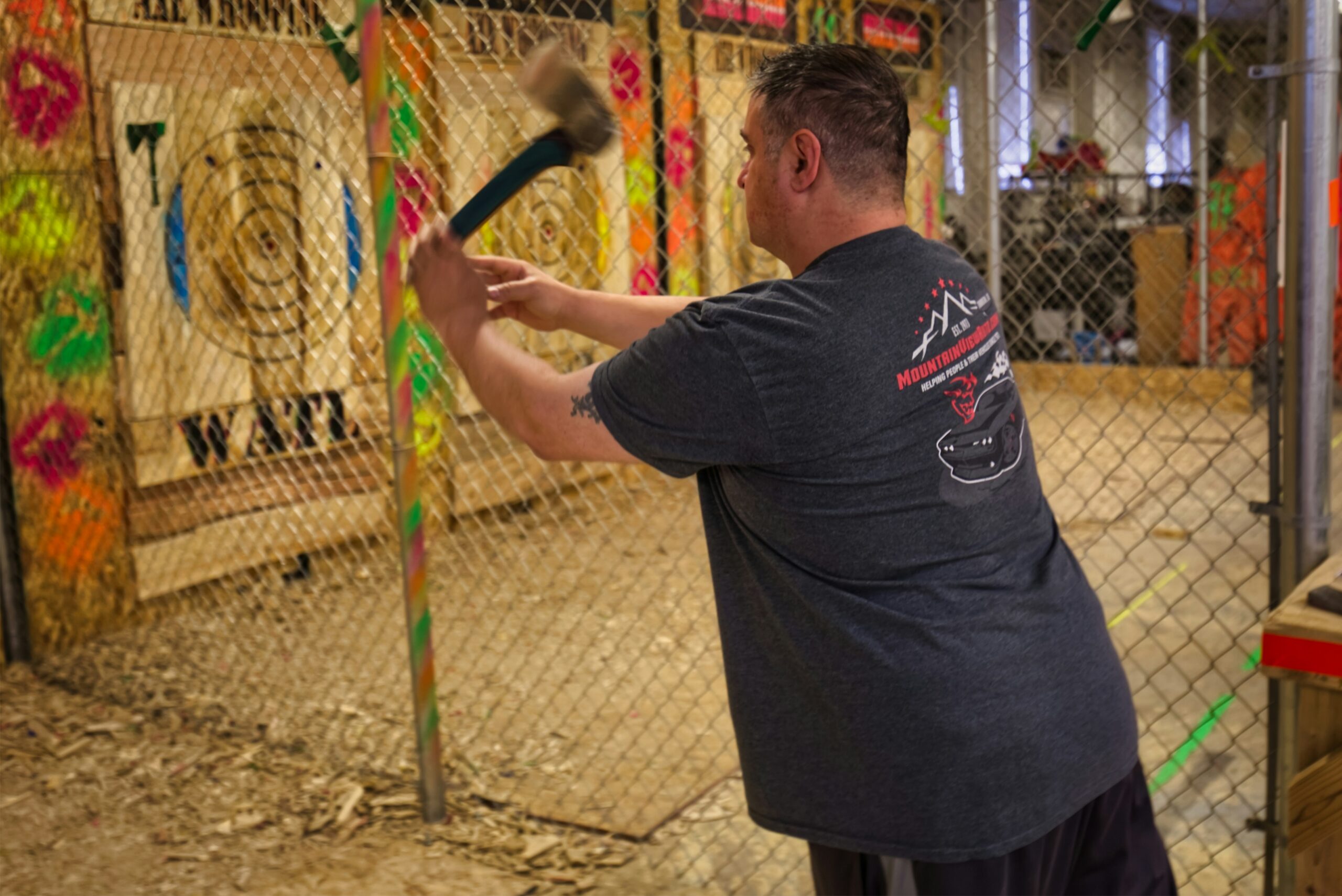Axe throwing is both an exhilarating and competitive activity, but understanding axe throwing league rules is essential for a safe and enjoyable experience. This article outlines the key rules, equipment standards, and competition structures that guide league play.
Participants will also gain insight into the expected code of conduct and what to anticipate in local axe throwing leagues. By familiarizing yourself with these guidelines, you can feel confident and prepared, whether you’re new to the sport or refining your skills.
Key Takeaways
- Axe throwing leagues focus on skill development and sportsmanship among participants
- Competitors must understand specific rules and scoring standards to compete fairly
- Safety gear, such as goggles and padded clothing, is essential during practice and competitions
- Participants need to meet age and training requirements before entering leagues
- Various formats, including playoffs and duals, enhance the excitement of axe throwing events
Essential Rules and Regulations

Understanding essential rules and regulations is crucial for anyone participating in axe throwing leagues. This section covers general gameplay rules, pre-game procedures, and expectations, along with scoring standards and practices. Safety regulations address injury prevention, while penalties for non-compliance, or faults, explain potential consequences. Information here is relevant for both regular matches and playoffs, ensuring a smooth gaming experience for all involved.
General Gameplay Rules for Leagues
In axe throwing leagues, players must follow distinct gameplay rules to ensure a fair competition. Each throw should showcase proper rotation, as this influences accuracy when aiming for the target. Competitors often use a hatchet, and understanding its weight and balance is essential for effective throws, especially in scenarios where a tie occurs. For parents who may be new to the sport, familiarizing themselves with these gameplay standards can enhance their child’s experience and performance in the league.
Pre-Game Procedures and Expectations
Before any axe throwing competition begins, participants need to follow specific pre-game procedures. This includes checking in at the registration desk, where competitors confirm their participation and receive any necessary equipment, such as axes or padding. Understanding these expectations helps players prepare mentally and physically, ensuring they are ready to showcase their skills while prioritizing safety and enjoyment during the events.
Scoring Standards and Practices
Scoring standards in axe throwing leagues are designed to ensure fairness and clarity during competitions. Each player earns points based on where their axes land on the target, with higher scores awarded for hitting the bullseye. Competitors should understand these scoring practices, as they play a crucial role in determining winners, especially in tightly contested matches where every throw counts.
Safety Regulations in Competitive Settings
Safety regulations are critical in competitive axe throwing settings to protect all participants. Proper equipment, such as safety goggles and padded gear, should be worn during practice and competitions to minimize injury risks. Referees also monitor each throw to ensure all players are following safety protocols, creating a secure environment for everyone involved:
- Wear safety goggles during competitions.
- Use padded gear to prevent injuries.
- Referees ensure safety regulations are followed.
Penalties for Non-Compliance
Penalties for non-compliance in axe throwing leagues serve to uphold the integrity of competitions and ensure a safe environment for all. Players who violate rules may face consequences such as point deductions, disqualification from matches, or even removal from the league. Understanding these penalties encourages participants to follow guidelines and maintain sportsmanship throughout the season:
- Point deductions for minor infractions.
- Disqualification from specific matches or tournaments.
- Possible removal from the league for serious violations.
Equipment Specifications and Standards

Understanding equipment specifications and standards is vital for anyone involved in axe throwing leagues. This section covers acceptable axe types and modifications, ensuring that participants use the proper tools for the sport. It also outlines the required target and lane dimensions, along with additional gear necessary for safety and competitive integrity. Each topic contributes to a fair and engaging axe throwing experience.
Acceptable Axe Types and Modifications
In axe throwing leagues, using the right type of axe is essential for competition and safety. Acceptable axe types typically include hatchets designed specifically for throwing, which should weigh between 1.5 to 2.5 pounds. Modifications like changing the handle or blade should comply with league standards, ensuring that all participants have equipment that performs consistently during matches:
- Hatchets should weigh between 1.5 to 2.5 pounds.
- Equipment modifications must follow league guidelines.
- Ensures fair play and safety for all competitors.
Target and Lane Dimensions
In axe throwing leagues, understanding target and lane dimensions is essential for creating a fair and competitive environment. The target should be eight feet tall and four feet wide, with specific scoring areas marked clearly, ensuring all players know how points are awarded. Additionally, lanes generally extend 12 feet from the throwing line to the target, allowing enough distance for safe throws and accurate scoring:
Additional Gear Requirements
In axe throwing leagues, additional gear requirements help ensure that all participants can compete safely and effectively. Competitors are typically expected to wear safety goggles to protect their eyes from stray axes or debris. Padded gear, such as knee pads and gloves, is also recommended to reduce the risk of injury while throwing. Meeting these equipment standards not only enhances safety but also promotes a positive sporting environment for everyone involved:
Structure of League Competitions

The structure of axe throwing league competitions includes several key components. First, the regular season format and schedules provide a framework for players to compete throughout specific weeks. Next, playoffs and championship events showcase the top performers battling for titles. Lastly, duals and other competitive formats offer varied opportunities for participants to display their skills in different settings.
Regular Season Format and Schedules
The regular season format for axe throwing leagues typically spans several weeks, allowing participants ample time to showcase their skills. Each week, players compete in scheduled matches where they earn points based on their performance. This structured environment not only encourages friendly competition but also helps participants gain experience and improve their techniques in preparation for playoffs and championship events.
Playoffs and Championship Events
Playoffs and championship events in axe throwing leagues serve as the pinnacle of competition, where the best performers vie for the title. These events typically follow a structured format, allowing participants to showcase their skills and strategies acquired during the regular season. The excitement in these final matches often reaches new heights, as competitors push their limits, aiming for accuracy and precision to secure their place as champions in the league.
Duals and Other Competitive Formats
Duals in axe throwing leagues present a unique format where two competitors face off directly, showcasing their skills in a head-to-head battle. This format enhances the excitement of the game, as both participants aim for the highest score while directly competing against each other. Additional competitive formats, such as team battles or timed challenges, offer varied experiences and can cater to different skill levels, making the sport accessible and engaging for all participants.
Participation Guidelines for Players

Participation guidelines for axe throwing leagues cover key areas that ensure a smooth experience for all competitors. The eligibility criteria outline who can compete, while the registration processes and fees provide essential steps for joining. Conduct expectations and a code of ethics emphasize sportsmanship among players, fostering a respectful environment throughout the season.
Eligibility Criteria for Competitors
Eligibility criteria for competitors in axe throwing leagues ensure that all participants meet specific standards for safety and skill. Generally, players must be at least a certain age, often 18 years or older, to enter competitions. Some leagues may also require participants to have completed a basic training session or safety briefing, ensuring everyone is prepared and knowledgeable about the game:
Registration Processes and Fees
To participate in axe throwing leagues, individuals must navigate the registration process, which typically includes filling out an application form and paying a fee. These fees often cover operational costs and safety training sessions, which are essential for ensuring that all competitors are well-prepared. Understanding the registration details helps players join leagues smoothly and enjoy a rewarding experience:
- Complete an application form.
- Pay the required registration fee.
- Attend any necessary safety training sessions.
Conduct Expectations and Code of Ethics
Conduct expectations and a code of ethics are vital in axe throwing leagues to promote a respectful and friendly environment among participants. Players are encouraged to treat each other with kindness, showing respect regardless of the competition’s intensity. Adhering to these standards not only enhances the experience for everyone involved but also reinforces the spirit of fair play that is central to the sport.
Conclusion
Comprehensive insights into axe throwing league guidelines are essential for fostering a safe and fair competitive environment. Understanding the rules, safety regulations, and equipment specifications ensures that all participants can perform to the best of their abilities. By promoting sportsmanship and respect, leagues can cultivate a positive atmosphere for both new and seasoned players. Overall, these guidelines enhance the experience for everyone involved, making axe throwing an enjoyable and engaging sport.

